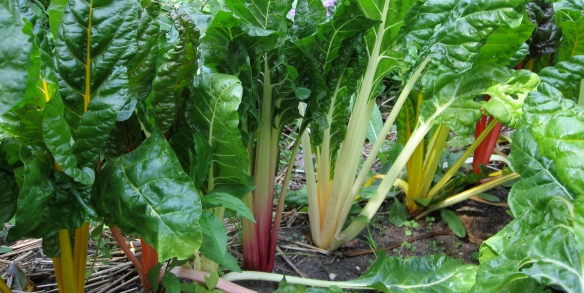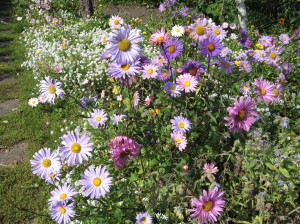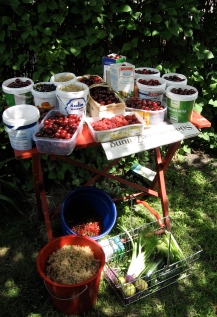 if new strawberry runners are planted in august, you get a full crop the following year. these ones have taken root nicely and are doing well. I used dried willow branches from last winter to make a little fence around the bed. it keeps the straw in and looks quite cute. I like it.
if new strawberry runners are planted in august, you get a full crop the following year. these ones have taken root nicely and are doing well. I used dried willow branches from last winter to make a little fence around the bed. it keeps the straw in and looks quite cute. I like it.
the soil in the old garden bed along the fence has been dreadful ever since we had the garden. it was pure sand which actually repelled water. so we decided to go the whole hog and completely renew the entire bed. we have used the following method successfully for several other garden beds as well.
step one
dig a hole as big as your new garden bed. it can be anything from 40-80 cm (15.7-31.4”)deep. deeper is possible but a lot more work and not really necessary. we spread the old soil across some paths and underneath some shrubs that did not mind a bit of extra sand. if your soil is too heavy for massive digging, consider a high rise bed and apply the following steps to the top soil. since we have easy to dig sandy soil, which has a tendency to dry out too quickly, we prefer flat garden beds.
step two
add a generous layer of coarse material: hedge cuttings, tree branches not much wider than a pencil, woody flower stalks etc. this layer will rot slowly and provide good drainage for the new garden bed. there is no need to build the new bed in a day. you can for example fill up the new garden bed over the course of several weeks in autumn, when there is a huge amount of material to get rid of anyway. if you are making a high rise bed on top of your old garden bed, consider placing a layer of well soaked, thick cardboard underneath this layer of coarse material to keep the weeds down.
step three
add a good mix of composting material:
lawn clippings – mix well with other stuff,
dead leaves,
rotten fruit – cover these well with some other material,
household compost – no meat, no cooked food to avoid a rat problem,
non flowering weeds,
animal manure – we use stuff from a children’s horse riding place in the city, they are giving it away for free,
anything you can find, and you and or your neighbours need to get rid of.
add as many different things as possible, general composting rules apply. you can build up this heap quite a bit higher than you want it to be in the end. it will shrink considerably as the material decomposes.
step four
once you filled up the hole, cover it with a good layer of compost that is not ready yet from your compost bin. the compost covers the bed and keeps it moist and dark, prevents smells and flies and will enable you to use the bed quicker than otherwise, because the top layer will be ready for planting quicker this way.
for the strawberry garden bed on the picture we added composted horse manure and not quite ripe compost directly on to the first coarse layer. as a result the new bed was ready to plant quickly in a few weeks time.
step five
cover the new bed with straw or wet cardboard and wait until millions of soil organisms have transformed the compost heap into your new most productive garden bed. if you build the new bed in early autumn it will be ready to plant in late spring. in our area there is no composting activity between november and february. the bed would be ready here by middle of may. plant things that do not mind fresh compost and like a lot of nutrients.
 when dry, chrunch the shells up and store them in an airtight container. properly dry eggshells will break forming realy sharp edges. slugs avoid crawling over the shells, it is like crawling on glass. I collect the egg shells all winter as I need a lot of them in spring. idealy get other people to collect them as well to increase the amount. advantages: this method is poison free, good for your soil, worms love egg shells, method works under wet conditions. disadvantage: you need a lot of egg shells, start collecting them early on.
when dry, chrunch the shells up and store them in an airtight container. properly dry eggshells will break forming realy sharp edges. slugs avoid crawling over the shells, it is like crawling on glass. I collect the egg shells all winter as I need a lot of them in spring. idealy get other people to collect them as well to increase the amount. advantages: this method is poison free, good for your soil, worms love egg shells, method works under wet conditions. disadvantage: you need a lot of egg shells, start collecting them early on.





 if new strawberry runners are planted in august, you get a full crop the following year. these ones have taken root nicely and are doing well. I used dried willow branches from last winter to make a little fence around the bed. it keeps the straw in and looks quite cute. I like it.
if new strawberry runners are planted in august, you get a full crop the following year. these ones have taken root nicely and are doing well. I used dried willow branches from last winter to make a little fence around the bed. it keeps the straw in and looks quite cute. I like it.




